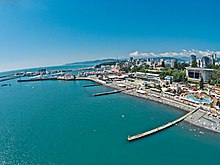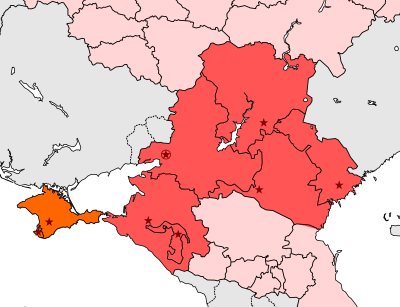Southern Federal District
Coordinates: 47°14′N 39°43′E / 47.233°N 39.717°E
Southern Federal District
Южный федеральный округ | |
|---|---|
Federal district of Russia | |
 Location of the Southern Federal District. Crimea, whose annexation by Russia from Ukraine is mostly unrecognized internationally, shown in orange. | |
| Country | |
| Established | 18 May 2000 |
| Administrative centre | Rostov-on-Don |
| Government | |
| • Presidential Envoy | Vladimir Ustinov |
| Area | |
| • Total | 447,900 km2 (172,900 sq mi) |
| Area rank | 7th |
| Population | |
| • Total | 16,319,253[2] |
| • Rank | 4th |
| • Density | 33.1/km2 (86/sq mi) |
| • Urban | 62.4%[2] |
| • Rural | 37.6%[2] |
| Federal subjects | 8 contained |
| Economic regions | 1 contained |
| HDI (2019) | 0.801[3] very high · 6th |
| Website | ufo |
The Southern Federal District (Russian: Ю́жный федера́льный о́круг, tr. Yuzhny federalny okrug, IPA: [ˈjuʐnɨj fʲɪdʲɪˈralʲnɨj ˈokrʊk]) is one of the eight federal districts of Russia. Its territory lies mostly on the Pontic–Caspian steppe of southern Russia. The Southern Federal District shares borders with Ukraine, the Azov Sea, and the Black Sea in the west, and Kazakhstan and the Caspian Sea in the east.[4] The Southern Federal District was originally called the North Caucasian Federal District when it was founded in May 2000, but was renamed for political reasons on 21 June 2000. On 19 January 2010, the Southern Federal District was split in two, with its former southern territories forming a new North Caucasian Federal District.[5]

On 28 July 2016 Crimean Federal District (which contains the Republic of Crimea and the Federal city of Sevastopol) was abolished and merged into Southern Federal District in order to "improve the governance".[6] Crimean Federal District was established on 21 March 2014 after the annexation of Crimea by the Russian Federation.[7] The federal district includes both the Republic of Crimea and the federal city of Sevastopol, both recognized as part of Ukraine by most of the international community. Ukraine considers the area, along with the areas of Luhansk People's Republic and Donetsk People's Republic, as temporarily occupied territories.[8][9] Its population was 13,854,334 (62.4% urban) according to the 2010 Census,[2] living in an area of 420,900 square kilometers (162,500 sq mi).[1]
Demographics[]
Federal subjects[]
| # | Flag | Federal subject | Area in km2[1] | Population | Capital/administrative center |
|---|---|---|---|---|---|
| 1 | Republic of Adygea | 7,800 | 447,109 | Maykop | |
| 2 | Astrakhan Oblast | 49,000 | 1,005,276 | Astrakhan | |
| 3 | Republic of Kalmykia | 74,700 | 292,410 | Elista | |
| 4 | Krasnodar Krai | 75,500 | 5,125,221 | Krasnodar | |
| 5 | Rostov Oblast | 101,000 | 4,404,013 | Rostov-on-Don | |
| 6 | Volgograd Oblast | 112,900 | 2,699,223 | Volgograd | |
| Disputed territories (with Ukraine) | |||||
| A | Republic of Crimea[a] | 26,100 | 1,966,801 | Simferopol | |
| B | Sevastopol[a] | 900 | 379,200 | Sevastopol | |
| |||||
Ethnic composition, according to the 2010 census: Total - 13 854 334 people.
Russians - 11,602,452 (83.75%)
Armenians - 442,505 (3.19%)
Ukrainians - 212 674 (1.54%)
Kazakhs - 205 364 (1.48%)
Kalmyks - 172,242 (1.24%)
Tatars - 127,455 (0.92%)
Adyghe (Circassian) - 121 391 (0.88%)
Azerbaijanis - 52 871 (0.38%)
Turks - 51,367 (0.37%)
Roma - 46,067 (0.33%)
Belarusians - 44 723 (0.32%)
Chechens - 34,593 (0.25%)
Georgians - 31,018 (0.22%)
Germans - 29 312 (0.21%)
Koreans - 27,640 (0.20%)
Greeks - 27,313 (0.20%)
Dargins - 24 815 (0.18%)
Uzbeks - 16 361 (0.12%)
Avars - 16,061 (0.12%)
Moldovans - 15 888 (0.11%)
Lezgins - 15 241 (0.11%)
Chuvash - 12 329 (0.09%)
Kurds - 12,056 (0.09%)
Bashkirs - 4 942 (0.06%)
Persons who did not indicate their nationality: 240 609 people. (1.74%)
Representatives of other nationalities: 729,572 people. (5.26%)
Presidential plenipotentiary envoys[]
1. Viktor Kazantsev (18 May 2000 – 9 March 2004)
2. Vladimir Yakovlev (9 March 2004 – 13 September 2004)
3. Dmitry Kozak (13 September 2004 – 24 September 2007)
4. Grigory Rapota (24 September 2007 – 14 May 2008)
5. Vladimir Ustinov (14 May 2008 – present)
References[]
- ^ a b c "1.1. ОСНОВНЫЕ СОЦИАЛЬНО-ЭКОНОМИЧЕСКИЕ ПОКАЗАТЕЛИ в 2014 г." [MAIN SOCIOECONOMIC INDICATORS 2014]. Regions of Russia. Socioeconomic indicators – 2015 (in Russian). Russian Federal State Statistics Service. Retrieved July 26, 2016.
- ^ a b c d Russian Federal State Statistics Service (2011). Всероссийская перепись населения 2010 года. Том 1 [2010 All-Russian Population Census, vol. 1]. Всероссийская перепись населения 2010 года [2010 All-Russia Population Census] (in Russian). Federal State Statistics Service.
- ^ "Sub-national HDI – Area Database – Global Data Lab". hdi.globaldatalab.org. Retrieved July 20, 2021.
- ^ "Southern Federal District, Russia Guide". russiatrek.org.
- ^ Президент Российской Федерации. Указ №849 от 13 мая 2000 г. «О полномочном представителе Президента Российской Федерации в федеральном округе». Вступил в силу 13 мая 2000 г. Опубликован: "Собрание законодательства РФ", №20, ст. 2112, 15 мая 2000 г. (President of the Russian Federation. Decree #849 of May 13, 2000 On the Plenipotentiary Representative of the President of the Russian Federation in a Federal District. Effective as of May 13, 2000.).
- ^ "Крымский федеральный округ включен в состав Южного федерального округа" (in Russian). Interfax. July 28, 2016. Retrieved July 28, 2016.
- ^ "В России создан Крымский федеральный округ". RBC. March 21, 2014.
- ^ Law about occupied territories of Ukraine. Mirror Weekly. 15 May 2014
- ^ Higher educational institutions at the temporarily occupied territories of Ukraine will not work – the minister of education. Newsru. 1 October 2014
External links[]
| Wikimedia Commons has media related to Southern Federal District. |
- Southern Federal District
- Federal districts of Russia
- Geography of Southern Russia
- States and territories established in 2000
- 2000 establishments in Russia

